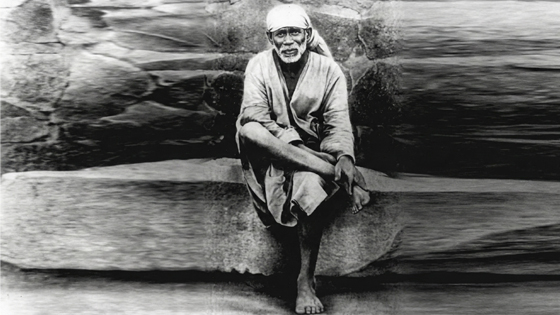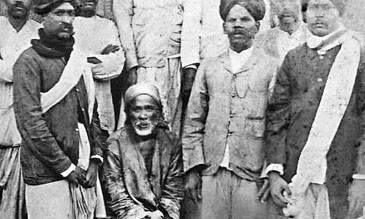Introduction
The extracts in this anthology are taken from Shri Sat Chaitra. The author, Shri Govind Raghunath Dabolkar alias Hemadpant refers to Saibaba his devotees and vision

Shri Sai Baba knew all yogic practices. He was well versed in the six processes, including Dhauti, Khanda Yoga and Samadhi, etc. He demonstrated His mastery over yogic exercises many times.
Yet, if you think that he was a Hindu, He looked like a Yavan. If you think Him to be a Yavan, he looked like a pious Hindu. No one knew whether he was a Hindu or a Mohammedan. Inferences could be drawn from His dress or body features, but all such superficial inferences were meaningless. They did not serve any purpose.
He celebrated the Hindu festival of Rama-Navami with all due formalities and at the same time permitted the ‘Sandal’ procession of the Mohammedans. He encouraged wrestling bouts in this festival and gave good prizes to winners. When the Gokul Ashtami came, he got the ‘Gopal-Kala’ ceremony duly performed and on Id festivals, he allowed Mohammedans to say their prayers (Namaj) in his masjid.
Once at the Muharram festival, some Mohammedans proposed to construct a Tajiya or Tabut in the Masjid, keep it there for some days and afterwards take it in the procession through the village. Sai Baba allowed the keeping of the Tabut for four days and on the fifth day removed it out of the Masjid without the least complication. He allowed all the devotees to celebrate festivals at Shirdi according to their preferences and the various religions in vogue adopted by them. In Baba's Masjid except a garlanded wall there is no image or photograph of any deity.
If we say that he was a Mohammedan, his ears were pierced (i.e. had holes according to Hindu fashion). If you think that he was a Hindu, he advocated the practice of circumcision (though according to Mr Nanasaheb Chandorkar, who observed him closely, he was not himself circumcised. Wide article in Sai Leela on 'Baba Hindu Ki Yavan' by B.V. Deo, page 562). If you call him a Hindu, he always lived in the Masjid; If Mohammedan, he had always the Dhuni - sacred fire there, and the following things which are contrary to Mohammedan religion, i.e., grinding on the hand mill, blowing of the conch and bells, oblation in the fire, Bhajan, giving of food, and worship of Baba’s Feet by means of ARDHYA (water) were always allowed there. If you think that he was a Mohammedan, the best of Brahmins and Agnihotris, leaving aside their orthodox ways, fell prostrate at his feet. Those who went to make inquiries about his nationality were dumbfounded and were captured by his Darshana. He gave visions of all the respective Gurus and deities according to devotees' choice whether expressed or hidden. Baba, when asked about his creed, said that he belonged to a Saint Kabir's creed.
So none could definitely decide whether Sai Baba was a Hindu or a Mohammedan. This is no wonder; for he who completely surrenders himself to the Lord, by getting rid of his egoism and body - consciousness thus becomes one with him, and has nothing to do with any questions of caste or nationality. Such a one as Sai Baba was, saw no difference between caste and among beings and beings. He took meat and fish with Fakirs, but did not grumble when dogs touched the dishes with their mouths. Thus Sai Maharaj was beyond all personal references, time and space dimensions.
Such a unique and wonderful GOD incarnation was Sai Baba.
[* Note--(1) Mhalsapati, an intimate Shirdi devotee of Baba, who always slept with Him in the Masjid and Chavadi, said that Sai Baba told him that he was a Brahmin of Pathari and was handed over to a Fakir in his infancy, and when He told this, some men from Pathari had come, and Baba was inquiring about some men from that place. [Video Sai Leela 1924, Page 179. (2) Mrs. Kashibai Kanitkar, the famous learned woman of Poona says of the experience No.8, published on Page 79, Sai Leela Vol. 11,1934, - 'On hearing of Baba’s miracles, we were discussing according to our theosophical convention and fashion whether Sai Baba belonged to black or white lodge. When I went to Shirdi, I was thinking seriously about this in my mind. As soon as I approached the steps of the Masjid, Baba came to the front and pointing to His chest and staring at me spoke rather vehemently - 'This is a Brahmin, pure Brahmin. He has nothing to do with black things. No Musalman can dare to step in here. He dare not.' Again pointing to his chest - 'This Brahmin can bring lacks of men on the white path and take them to their destination. This is a Brahmin’s Masjid and I won’t allow any black Mohammedan to cast his shadow here.']
Sai Baba is widely regarded as an incarnation of God, but he always said that he was an obedient servant of God. Through an incarnation he showed the people the way how to behave satisfactorily and carry out the duties of their respective stations (Varnas) in this life. He never emulated others in any way, nor asked others to have something done for him. For him, Who saw the Lord in all movable and immovable things of this world, humility was the most proper thing. None he disregarded or disrespected; for he saw Narayan (Lord) in all beings, he never said, 'I am God,' but that he was a humble servant and he always remembered him and always uttered - 'Allah Malik' (God is the sole proprietor or Owner). By his thoughts and worldly behavior He established ideal values and virtues of faith, patience and humanity. One should concentrate on and do faithfully one's duties assigned to him/her by GOD and wait patiently for the results (fruits) of his action (Karma) because the effect of any cause is always determined by GOD.


Introduction

Wonderful Carnation

Origin of Shri Sai Baba

Greatness of Sai Baba Udi

Shri Sai Baba’s Advice

Our Mission and Values
Annadhanam (Free Prasad Bhojan)
During Weddings, Birthdays and Special Occasions, make a sacred offering of food, which will provide sustenance for worshippers in the Shri Saibaba Sansthan Trust.
In honor of your ancestors, make a sacred offering of food, which will provide sustenance for worshippers in the Shri Saibaba Sansthan Trust.


 Subscribe
Subscribe
